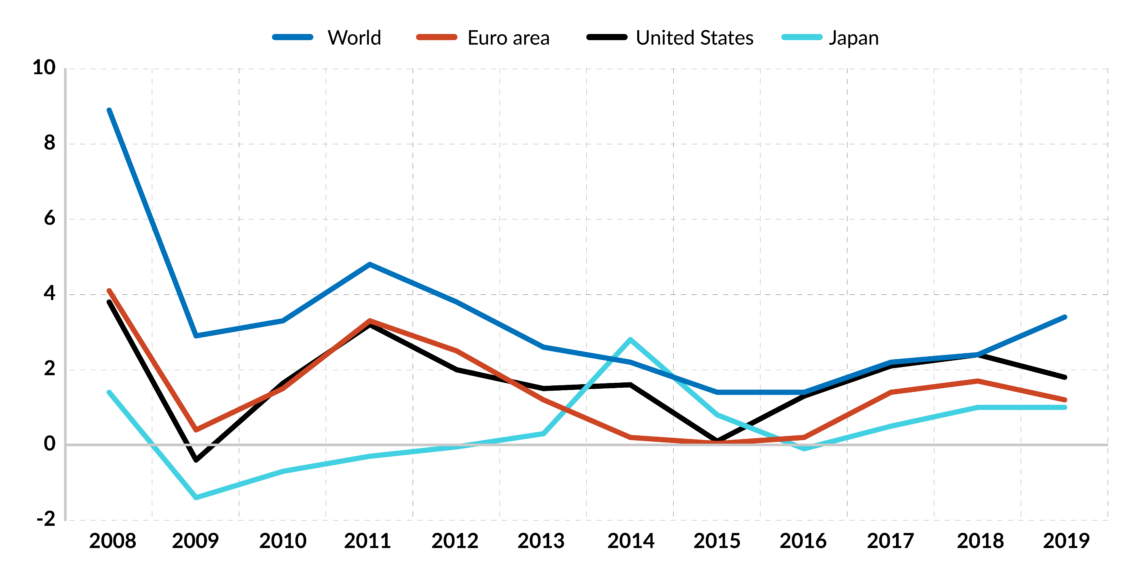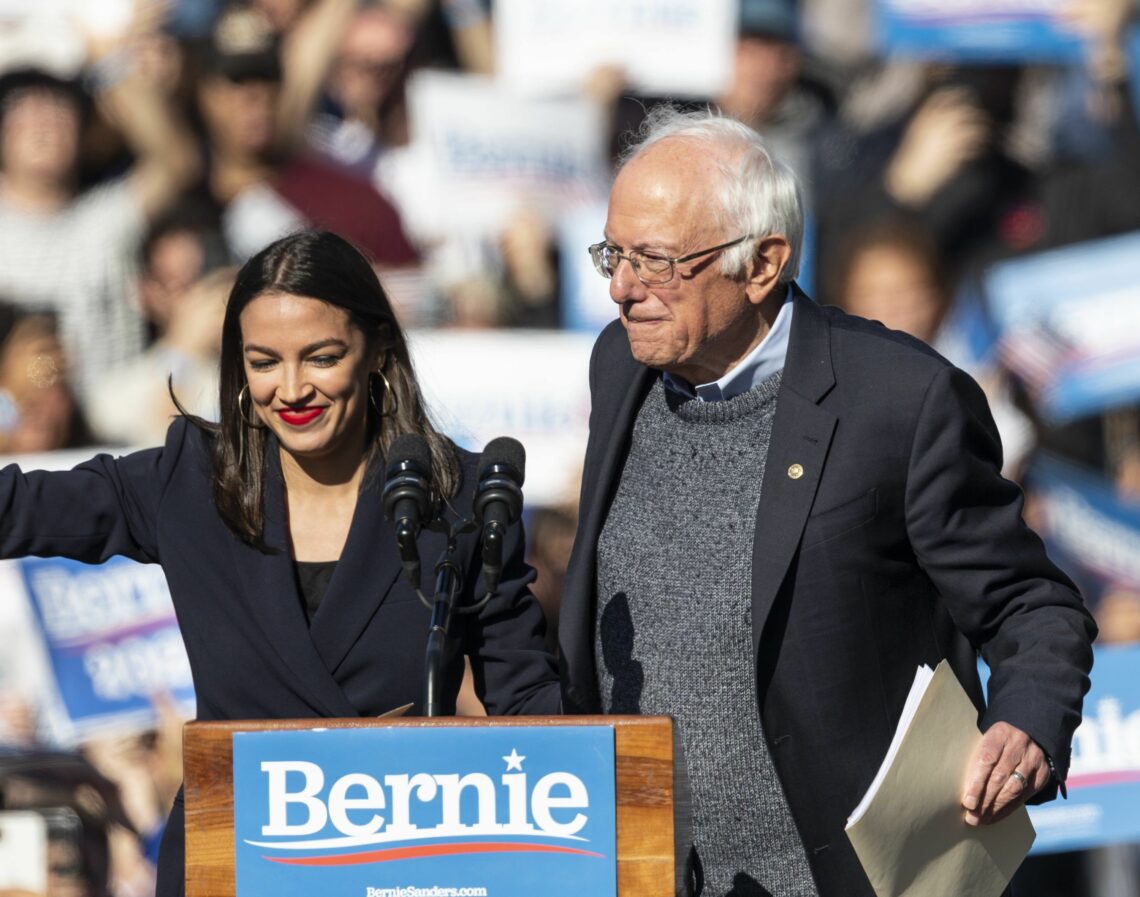Modern Monetary Theory: The future of money?
Modern Monetary Theory (MMT) has become a popular philosophy among advocates of government spending. Traditional economics holds that MMT would lead to inflation, yet its proponents argue that the orthodoxy no longer applies.

In a nutshell
- MMT offers a justification for high spending and taxation
- Politicians of all stripes have embraced its tenets
- Such policies have been tried before, and failed
In 2019, a heterodox trend in economic thinking rose to prominence: Modern Monetary Theory (MMT). It posits that monetary policy is not a viable macroeconomic tool and that governments should concentrate on fiscal policy and finance public spending – including employment programs – by issuing money. Despite the traction it has gained, MMT is riddled with problems.
Fiscal power
The first MMT macroeconomics handbook, written by William Mitchell, Martin Watts and Randall Wray and published by MacMillan in 2019, sold out just two months after it was released. Clearly, the theory has a growing fan club in academia.
Ray Dalio, a famous economist and founder of the Bridgewater Associates hedge fund, is a proponent of MMT. Some left-wing politicians in the United States have used MMT to defend their expansionary fiscal policy proposals. Representative Alexandria Ocasio-Cortez, for example, sees it as a way to finance a Green New Deal. Presidential candidate Senator Bernie Sanders was previously advised by MMT economist Stephanie Kelton. He could use her ideas to suggest ways to finance the government-funded healthcare and education he promises to implement.
According to MMT, governments should use fiscal policy to stabilize and stimulate economies. Nations should free themselves from the ‘cult of austerity’.
According to MMT, low interest rates (which make it easier for governments to borrow) and low inflation now seem to be persistent. Since, in their view, monetary policy does not work anymore, governments should therefore use fiscal policy to stabilize and stimulate economies. Nations should free themselves from the “cult of austerity,” and, in Europe, from the “shackles” of the Stability and Growth Pact, which caps budget deficit at 3 percent of gross domestic product (GDP) and public debt at 60 percent of GDP.
Money printing
Unlike a household, a government cannot, according to MMT, default in its own currency. Governments can issue money using the central bank’s “printing press” to finance deficit spending and repay their public debt. Based on a chartalist vision of money, MMT envisions currency as an IOU that the government circulates via expenditure and whose value derives from it being the currency with which citizens pay their taxes.
Governments should therefore print money and spend until the economy reaches full employment: fiscal policy is financed by money creation. In theory, inflation should not pick up before full employment. When this occurs, increasing taxes would “stabilize” inflationary trends by taming rising demand. Under this system, taxes are not supposed to pay for collective goods (as this is done by printing money), but are a means to tame inflation and, also, inequality. MMT advocate Warren Mosler suggests a zero percent interest rate.
MMT makes the government an “employer of last resort” so as to reach full employment, with a “jobs guarantee” program. The idea is to maintain workers in productive activities rather than have them wait for their unemployment benefit while their human capital erodes. According to the theory, this would also have a positive impact on aggregate demand, which would then render entrepreneurs’ expectations more optimistic and encourage them to hire employees. Various sectors could supposedly benefit from such programs – which, given the magnitude of intervention, makes MMT rather reminiscent of central planning.
Inflation matters
Serious criticisms abound. Chile under President Salvador Allende (1970-1973) or Venezuela under President Nicolas Maduro (2013-present) have embraced monetary policies very similar to MMT, and the result was hyperinflation. Many other cases come to mind, from Argentina to Brazil. MMT answers these claims by pointing out that there has not been inflation for the past decade in the developed West despite extraordinary monetary policies. However, the real reasons for this state of affairs are twofold.
Facts & figures

First, from a market perspective, technological progress has allowed entrepreneurs to cut costs. Competition – especially due to globalization – has forced them to translate these lower costs into lower prices for consumers, thus lowering inflation. But a rise in protectionism would counteract these trends. And given the potential impact of MMT proposals on productivity and prices, it is hard to see how it could not gradually lead to protectionist measures.
From a monetary standpoint, today’s low inflation is the result of contradictory monetary policy. Central banks appeared to engage in expansionary policy, using quantitative easing. Some more than quadrupled their assets. At the same time, however, they wanted to avoid runaway inflation: the U.S. Federal Reserve, for instance, imposed interest on reserves. Then low rates compressed banks’ margins, inducing banks to turn away from lending (and thus money creation), and toward activities such as insurance.
More importantly, banking regulations became very restrictive, as economist Steve Hanke has pointed out. The mechanisms of monetary policy transmission were broken, and inflation did not occur. If MMT policies were to bypass such (now broken) traditional channels, inflation would surely come back. Fiscal policy would be of no use in this case.
Knowledge problem
The extent of government control over the economy suggested by MMTers would raise two classic economic problems. The first is the crowding-out effect, in which private investment is underfunded because resources are diverted to public investment. The second is the “knowledge problem,” in which scarce resources are misallocated by bureaucrats who are not putting their own money at risk. Productivity would suffer.
Moreover, in a world of official 0 percent interest rates and “free money,” who would need banks? Would the traditional role of bankers not disappear? One could argue that bankers’ role has already been weakened – precisely because of policies that increasingly resemble MMT. Bankers play a fundamental entrepreneurial role in allocating scarce capital. Savings also have an essential role to play, not only to finance investment but also to allow people to plan their future. Perpetual 0 percent interest rates would certainly have a negative impact here.
According to MMT, governments should use fiscal policy to stabilize and stimulate economies. Nations should free themselves from the ‘cult of austerity’.
With the government financing its own debt by printing money, it risks losing credibility in financial markets, and possibly defaulting. There are many examples of such occurrences throughout history. Obviously, the U.S. dollar is not at risk. But the rise of other powers could change the circumstances. Moreover, MMT forgets that every country is bound by the global market and factors like import and export prices.
Democracy adrift
MMT could lead to problematic outcomes beyond the usual economic issues. If the government supports particular sectors, lobbying will increase, developing so as to exploit government patronage. Public choice theory warns of the damage lobbying does as an unproductive activity, but under MMT the negative effects would spiral out of control. Several countries in Latin America have recently demonstrated how “government support” for certain sectors leads to collusion and corruption. A creeping collectivization of the economy would have negative consequences for democracy as well.
Democratic accountability would also be considerably weakened because taxes would not be levied to pay for public goods but to regulate inequality and inflation (though raising taxes in a context of inflation would be politically complex). If direct taxes – such as the income tax – are eliminated for most, and these are replaced with indirect taxes that hide the cost of government, then democratic accountability weakens. Coupled with a growing debt, such a system would institutionalize fiscal illusion. And inflation created by the government’s money printing policies could constitute a form of hidden taxation.

Finally, it is hard to imagine an independent society in which an ever-larger number of citizens depends on the government for guaranteed jobs (or if all of them depend on the state for their Universal Basic Income). Democracy and accountability would suffer. People would become “electoral clients” of politicians and “subjects of the state.” The possibility of democracy in (even partially) collectivist regimes has proven to be utopian wishful thinking. We have ample historical evidence of how such systems end.
Foes and potential friends
Keynesians would agree that some MMT measures might be justified, but only in extreme circumstances, to avoid a depression. They do not believe its precepts should be used all the time. In fact, many criticisms of MMT come from the Keynesian camp. Paul Krugman and former U.S. Treasury Secretary Lawrence Summers, for example, warn that it would bring high inflation. Former International Monetary Fund chief economist Kenneth Rogoff called MMT “nonsense.” Christine Lagarde, then head of the IMF, recalled Milton Friedman’s saying that “there is no such thing as a free lunch.” Former Fed Chair Janet Yellen warned that MMT was a “wrong-minded theory” and that it would lead to hyperinflation. Current Fed Chair Jerome Powell said a year ago “the idea that deficits don’t matter for countries that can borrow in their own currency, I think, is just wrong.”
So it seems MMT is wrong for the economy and for democracy. Yet more and more economists and political leaders talk about using expansionary fiscal policy given today’s low inflation and low borrowing costs for governments. It seems the public dialogue is implicitly leaning more and more toward MMT proposals. Its criticism of the “cult of austerity” has a nice ring to it, and could serve many people’s interests. And many EU countries have not respected the euro convergence criteria. Why ask them to start now?
With policy rates at near zero and quantitative easing strategies unable to bring about recovery, monetary policy seems out of ammunition.
French President Emmanuel Macron, for example, referred to the 3 percent of GDP limit for deficits as a rule that “belongs to another century.” Former IMF economist Olivier Blanchard said that when monetary policy is ineffective, fiscal policy remains the only lever to increase demand, and thus production and employment. (He added, however, that he does not advocate for excessive levels of public debt.) Many others are similarly inclined.
Mainstream monetary policy?
It seems the consensus born in the 1980s from both monetarist and new Keynesian theories is slowly fading. It was based on central bank independence and “supply-side” reforms implemented by the government. In case of a recession, central banks would intervene with lower rates and governments could run deficits to stimulate recovery. It seemed that “brutal” business cycles were finally tamed: this was the Great Moderation.
The 2008 crisis put an end to all that. The consensus was discredited and both of its pillars have been gradually weakened over the past decade, putting us on a path that could lead to MMT. As explained in another GIS report, central bank independence is in danger. With policy rates at near zero and quantitative easing strategies unable to bring about recovery, monetary policy seems out of ammunition. Moreover, these ultra-low interest rate policies have created asset bubbles, which have in turn led to higher inequality. In some countries, this state of affairs has been aggravated by austerity measures.
Politicians on the right, left and center are pushing for expansionary fiscal measures.
Many mainstream economists warned in 2008 that extraordinary monetary policies would lead to high inflation. Their predictions proved false because they focused on the wrong money measures and overestimated monetary transmission mechanisms. The result was to undermine claims today that MMT would bring high inflation.
‘Good’ crisis
These are crucial times: an admittedly not ideal but more-or-less functioning consensus has been weakened, and populist politicians on the right, left and center are pushing for more expansionary fiscal measures. Were a crisis to erupt, there is a high probability that they will take advantage of it to implement some MMT prescriptions.
In the 1930s, Maynard Keynes became so famous because he suggested proactive policies in a time of distress – precisely when people demanded action from their leaders. While the real reasons for the severity of the Great Depression were not Keynesian policies, it is hard not to see a parallel with today. As in the 1930s, this “new” analysis is incorrect. MMT cannot explain why the decades-long consensus failed, mainly for three reasons.
First, the consensus system forgot about responsibility (or “endogenous regulation”) in the banking sector by concentrating on macro/quantitative aspects rather than micro/qualitative/institutional incentives. The 2008 crisis was a crisis caused by irresponsibility – which was unfortunately not cured by more “exogenous regulation.” Capitalism does not work when the decision makers do not have any skin in the game.
Second, it failed to push accountability in politics. Third, as recalled by Steve Hanke, the new consensus on monetary policy in the 1980s focused on interest-rate targets rather than money aggregates. In fact, it is the growth of money that matters for economic growth – these two phenomena need to be in sync.
More fiscal and monetary responsibility and more democratic accountability are required today. MMT would take us in the opposite direction. Unfortunately, many are eager to head down that road.







